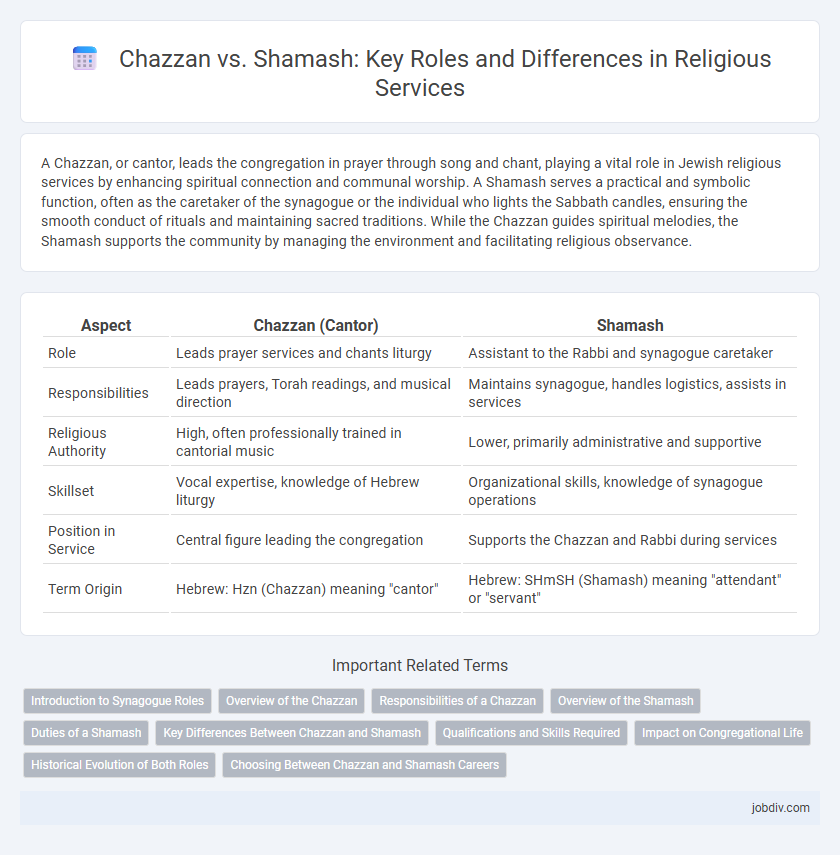A Chazzan, or cantor, leads the congregation in prayer through song and chant, playing a vital role in Jewish religious services by enhancing spiritual connection and communal worship. A Shamash serves a practical and symbolic function, often as the caretaker of the synagogue or the individual who lights the Sabbath candles, ensuring the smooth conduct of rituals and maintaining sacred traditions. While the Chazzan guides spiritual melodies, the Shamash supports the community by managing the environment and facilitating religious observance.
Table of Comparison
| Aspect | Chazzan (Cantor) | Shamash |
|---|---|---|
| Role | Leads prayer services and chants liturgy | Assistant to the Rabbi and synagogue caretaker |
| Responsibilities | Leads prayers, Torah readings, and musical direction | Maintains synagogue, handles logistics, assists in services |
| Religious Authority | High, often professionally trained in cantorial music | Lower, primarily administrative and supportive |
| Skillset | Vocal expertise, knowledge of Hebrew liturgy | Organizational skills, knowledge of synagogue operations |
| Position in Service | Central figure leading the congregation | Supports the Chazzan and Rabbi during services |
| Term Origin | Hebrew: Hzn (Chazzan) meaning "cantor" | Hebrew: SHmSH (Shamash) meaning "attendant" or "servant" |
Introduction to Synagogue Roles
The Chazzan, also known as the cantor, leads prayer services through melodic chanting, guiding the congregation in worship and maintaining liturgical rhythm. The Shamash serves as the synagogue's caretaker, assisting with practical tasks such as opening and closing the ark, preparing the Torah scrolls, and supporting the rabbi during ceremonies. Both roles are vital for the smooth functioning of synagogue services, blending spiritual leadership with logistical support.
Overview of the Chazzan
The Chazzan, also known as the cantor, plays a central role in Jewish religious services by leading the congregation in prayer through melodic chanting and vocal artistry. This spiritual leader is responsible for guiding liturgical songs, enhancing communal worship, and preserving traditional melodies that enrich the synagogue experience. Unlike the Shamash, whose duties are primarily practical and administrative, the Chazzan's function is deeply rooted in musical and religious expression, fostering a profound connection between the community and their faith.
Responsibilities of a Chazzan
A Chazzan leads the congregation in prayer, using vocal skills to enhance the spiritual experience and maintain liturgical accuracy. Key responsibilities include chanting prayers, Torah readings, and guiding communal participation during services. The Shamash primarily manages synagogue operations and assists the Rabbi, whereas the Chazzan focuses on the musical and prayer leadership aspects.
Overview of the Shamash
The Shamash is a synagogue attendant responsible for maintaining the sanctity of the prayer space and assisting the Chazzan during services. This role involves tasks such as preparing prayer books, lighting candles, and ensuring proper decorum throughout the service. The Shamash's duties support the smooth conduct of rituals, distinguishing it from the Chazzan's primary role of leading the congregation in prayer and chanting.
Duties of a Shamash
The Shamash serves as the designated caretaker of the synagogue, responsible for lighting and extinguishing the candles during services and maintaining the sanctity of the holy space. This role includes preparing ritual objects, organizing prayer books, and assisting the Chazzan by ensuring that the congregation's needs are met during worship. The Shamash also oversees the upkeep of the synagogue, supporting the smooth conduct of religious ceremonies and fostering communal respect for tradition.
Key Differences Between Chazzan and Shamash
The Chazzan, or cantor, leads the congregation in prayer through vocal melodies and chants, serving as the primary spiritual guide during services. The Shamash acts as the synagogue caretaker, responsible for maintaining the synagogue's physical space and assisting with ritual objects such as lighting the menorah or handling Torah scrolls. Unlike the Chazzan's liturgical role, the Shamash's duties are primarily practical and operational within the synagogue community.
Qualifications and Skills Required
A Chazzan requires advanced vocal skills, deep knowledge of liturgical melodies, and the ability to lead congregational prayers with emotional resonance. The Shamash must be well-versed in synagogue protocols, possess organizational skills, and offer support to the Rabbi, often managing community affairs. Both roles demand a strong commitment to Jewish law and tradition, but the Chazzan emphasizes musical proficiency while the Shamash focuses on administrative and communal responsibilities.
Impact on Congregational Life
The Chazzan leads the congregation in prayer, creating a spiritual atmosphere that enhances communal worship and fosters a strong sense of unity. The Shamash supports ritual organization and practical needs, ensuring smooth service flow and maintaining order within the synagogue. Their combined roles significantly impact congregational life by balancing spiritual leadership with operational management.
Historical Evolution of Both Roles
The role of the Chazzan evolved from ancient Jewish liturgical singers who led prayers in the synagogue, becoming a central figure in Jewish worship by the medieval period due to their musical and spiritual leadership. The Shamash, originally a historical helper or attendant to the Rabbi or synagogue leaders, took on responsibilities such as maintaining the synagogue, assisting with rituals, and managing community needs, solidifying its administrative and supportive role over time. Both roles developed distinctly yet complementarily, reflecting the adaptive structure of Jewish communal religious life through centuries.
Choosing Between Chazzan and Shamash Careers
Choosing between a Chazzan and Shamash career involves evaluating distinct religious roles with unique responsibilities: the Chazzan leads prayer services, requiring strong vocal skills and deep knowledge of liturgy, while the Shamash manages synagogue operations and assists with community rituals. Career preference depends on whether one is drawn to spiritual leadership or administrative support within Jewish worship settings. Both paths offer meaningful contributions to religious life, emphasizing different facets of communal engagement and tradition preservation.
Chazzan vs Shamash Infographic

 jobdiv.com
jobdiv.com